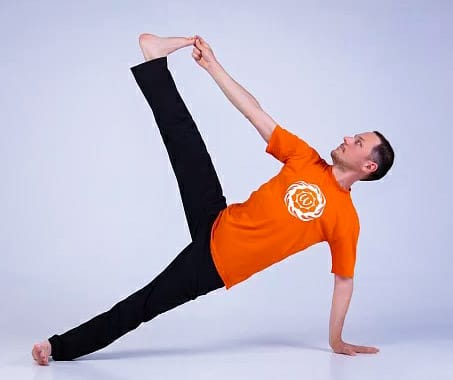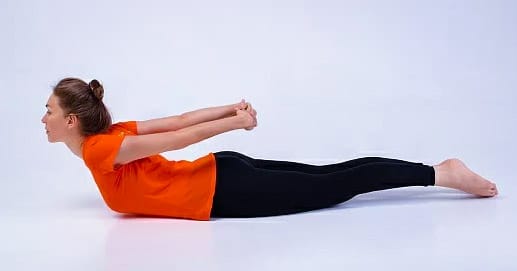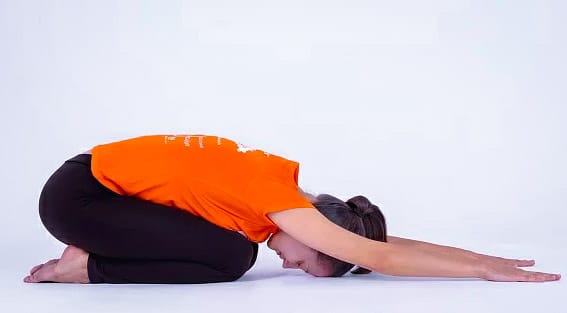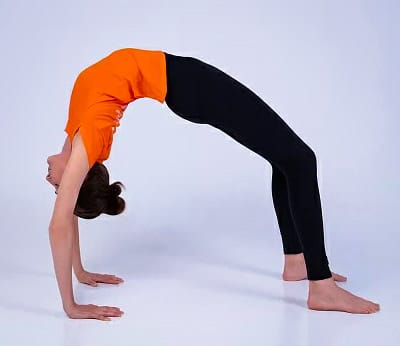Beginner's yoga for the back and spine
A modern variation of yoga that tackles problems with the spine and posterior core muscles is known as yoga for the back and spine.
yoga's positive effects on the back
Exercises in therapeutic yoga for the spine can be done on a regular basis and have the following advantages:
- Increased blood flow prevents unpleasant feelings and keeps osteochondrosis signs like protrusions, hernias, spondylosis, and spondylarthrosis at a distance.
- strengthening the core muscles, which form the proper posture and act as a supportive and stabilizing corset for the spine.
- Nervous system calming. A person with chronic pain also has chronic stress. Yoga lessons assist in redirecting the dominating discomfort to other bodily feelings.
- The cardiovascular system is trained by performing dynamic exercises from the "yoga for the back" complex continuously for 20 minutes.
- The goal of a well-designed complex is to stretch the muscles once they have been strengthened, which results in a sensation of joy and liberation.
- The homogeneous distribution of muscle tone results from dynamic relaxation and muscle contraction, and the PIR approach makes it feasible to achieve deep muscle relaxation.
- Shavasana and yoga nidra are relaxation methods that help to relieve the mental stress brought on by typical discomfort.
- Increases metabolism, and yoga is no different!
- The attitude elevates. Endorphins, happy hormones, are created when you exercise.
- Insulin sensitivity rises in type 2 diabetics, which lowers the body's insulin levels.
Contraindications
- A rise in body temperature above 37 °C is referred to as fever.
- Hemoglobin levels, leukocytes, and ESR have changed in the clinical blood test.
People with BACK PAIN can be younger than 20 or older than 55. Osteochondrosis is impossible before the age of 20, and the risk of oncological disorders rises after the age of 55. In order to avoid making the issue worse, it is essential to perform an MRI to clarify the diagnosis.
- The cancerous process is described in the anamnesis.
- New injury.
- Violation of the sexual, urogenital, and fecal functions of the pelvic organs. To get the diagnosis clarified, you must visit a doctor.
- Neurological symptoms (such as numbness, tingling, burning, and muscle weakness) are increasing quickly. To get the diagnosis clarified, you must visit a doctor.
- Taking glucocorticoids in high dosages (more than 7 mg per day) and for a long period of time (more than 3 months).
- Loss of weight without cause. To get the diagnosis clarified, you must visit a doctor.
- Increased discomfort when lying flat. To get the diagnosis clarified, you must visit a doctor.
- If you are treating your pain but seeing no results after more than a month. To get the diagnosis clarified, you must visit a doctor.
Any practice should be carried out comfortably, without experiencing any discomfort. Always begin with a limited range of motion and build it up over time.
A series of spine-friendly yoga poses
We will examine a number of exercise categories in this section, including:
- Back pain exercises (after the exacerbation phase):
- Yoga for newcomers is a streamlined version.
- Beginner yoga is a full range of styles.
- Exercise routines for a pain-free back.
Warming up all significant joints is advised before performing activities.
Back pain exercises (after the exacerbation period)
In dynamics No. 1, Marjariasana
- Go down on all fours.
- Straighten and raise your right leg as you inhale.
- Stretch your nose to your knee and your knee to your nose while exhaling.
- Run dynamically for no more than one minute.
- Comparable steps for the other side.
In dynamics No. 2, Marjariasana
- Go down on all fours.
- Bring your left leg back and your right hand forward, both parallel to the floor, as you inhale.
- Stretch your left knee to your elbow and your right elbow to your right knee while exhaling.
- Run dynamically for no more than one minute.
- Comparable steps for the other side.
Implementation contraindications include acute back pain.
Urdhva Chaturanga Dandasana (Plank Pose):
Simple version
- Get down on all fours and lower your arms so they are parallel to the ground. your shoulders with your elbows there.
- Stretch your feet back and lift your knees.
- Indicate the navel with the pubic bone.
- Keep your position for as long as you can.
Complete variant
- With support on the palms, which are situated beneath the shoulders, the adjustments are the same.
Side plank pose (vasisth asana)
Streamlined version:
- Your right forearm should be on the floor with a 90-degree angle at the elbow while you lie on your right side.
- Place the lower leg of the right side parallel to the right forearm by bending the knee.
- Try to lift your pelvis as high as you can. The pelvis can be raised and lowered or held on weight.
- Lift your left leg as high as you can while maintaining balance (you can lift it up and down).
- Comparable steps for the other side.
Complete variant
- Take up the plank position as described above.
- With a breath in, shift your weight to your left palm and turn your body to the right, following your feet's toes.
- Take your right hand and raise it. Put one foot in front of the other while also rotating your feet to the left.
- As long as possible, hold the position.
For the full version, the following conditions are contraindicated: pregnancy, spinal injuries, as well as damage to the wrists and shoulder joints.
Dandasana
- Straighten your torso while sitting with your pelvis on the floor.
- Straighten your legs and bring them together.
- With your palms towards your hips, push off the ground.
- As long as possible, hold the position.
Known as the "Snake Pose,"
- On your stomach, lie down.
- Palms facing down, place your hands along the body (you can lock them at the waist and extend them back).
- Lift your body with an inhalation while keeping your feet on the ground. The eyes are fixed downward.
- Breathe out as you relax and lower yourself.
- Run dynamically for no more than one minute.
- The asana can be held in place for as long as is practical.
Half-Locust Pose, or Ardha Shalabhasana
- On your stomach, lie down.
- Put your palms up and place your hands along the body. Sit down and chin down.
- Straighten your right leg as you inhale.
- Exhale more deeply.
- Run dynamically for no more than one minute.
- Comparable steps for the other side.
- The static can be held for as long as is practical.
Locust Pose, or Shalabhasana
- On your stomach, lie down.
- Your thighs will feel pressure from your palms. Legs are joined together.
- Lift your torso up as you inhale, bringing your shoulder blades together in the middle.
- Exhale more deeply.
- Run dynamically for no more than one minute.
- The asana can be held in place for as long as is practical.
(Unsuppo Cobra Pose) Niralamba Bhujangasanarted
- On your stomach, lie down. Legs are joined together.
- The lock behind your head is where you should gather your hands. Look below.
- Lift the body as high as you can with an inhalation.
- Exhale more deeply.
- Run dynamically for no more than one minute.
- The asana can be held in place for as long as is practical.
Shashankasana, which will let you relax your lower back and extend your back muscles, should be done towards the conclusion of the series of exercises.
Shashankasana
- Go down on all fours.
- With your head on the floor, lower your pelvis to your heels.
- Do not retain your elbows on weight when you extend your arms forward and place them on the ground.
Menstruation, pregnancy, spinal injuries, excessive blood pressure, and acute inflammatory illnesses of the internal organs are contraindications (for all positions resting on the stomach).
Back workouts that are painless
Mukha Svanasana Urdhva
- On the ground, lie flat on your stomach. Hip-width between your feet.
- Your palms should be on the floor, one on either side of your chest.
- Lift your body up by inhaling and lifting your knees and hips with your palms.
- Fingers facing forward, place your palms under your shoulders. Retract your shoulders. Do not tilt your head back toward your shoulders when looking forward.
- Stay as long as you find comfortable.
Pregnancy, wrist and spine problems and headaches are all contraindications.
Inverted Bow Pose, or Urdhva Dhanurasana
- Kneel down on the floor with your feet under your pelvis and lie on your stomach.
- With your fingers pointing in the direction of your shoulders, place your hands close to your shoulders.
- Push your palms off the floor, lift your chest, and squeeze your glutes while you lift your pelvis. Keep your elbows from flaring out to the sides.
- Execute a few techniques, alternating between hugging and stretching your legs to your forehead.
Pregnancy, wrist and spine injuries, and other contraindications.
Asana of Paripurna
- Straighten your legs as you sit with your pelvis on the floor.
- Lean back a little and breathe out.
- Raise your legs so that they are straight and your toes are pointed away from you so that your thumbs are at or above eye level.
- As long as possible, hold the position.
- With your fingers pointing back, place your palms flat on the ground behind your feet.
- Moving your hands smoothly in the direction of your feet (you can place your palms on your heels), raise your pelvis, and direct it forward and upward.
- As long as possible, hold the position.
- Reverse the sequence of exit.
- Pregnancy, brain circulation issues, severe spine issues, high blood pressure, and recent abdominal organ operations are all contraindications.
Exercises to relax the back muscles and reduce fatigue
Strangely enough, one must contract their abdominal muscles in order to relax their back, especially their lower back. Exercises to decrease (strengthen) the abdominal muscles will therefore be the ideal finish, which will also be a stretch for the back and spine.
Version 1 of Ardha Navasana in simpler form:
- Lay down on your back. below the knees, with feet hip-width apart.
- Put your palms up and place your hands behind your head.
- Stretch your arms forward (parallel to the floor) toward your feet as you exhale, lifting your torso and head. The body needs to be evenly balanced.
- Take a deep breath in and relax.
- Run dynamically for no more than one minute.
- The static can be held for as long as is practical.
Simpler version #2:
- Lay down on your back. Arms parallel to the body, feet hip-width apart, and under the knees.
- Stretch your right knee to your forehead and your right forehead to your knees while exhaling.
- Arms extended, reach for your feet.
- As long as possible, hold the position.
- Comparable steps for the other side.
Complete variant
- Your feet should be hip-width apart as you lay on your back with your knees bent.
- Exhale and lift your arms, body, and head upward (chin to chest).
- Raise your legs so that they are straight and around 40 to 50 cm above the ground.
- Keep your lower back firmly pushed to the floor at all times!
- As long as possible, hold the position.
Menstruation, severe back pain, a recent spinal injury, acute inflammatory disorders of the internal organs, and high blood pressure are all contraindications.
"Shell"
- Lie on your back.
- Raise your knees and stack your shins in the shape of a cross.
- Put your palms together and insert them inside the lock behind your head. Sit down and chin down.
- Lift your torso up and extend your knees toward your forehead while exhaling.
- Lower yourself as you inhale.
- Run dynamically for no more than one minute.
Regular physical activity is advised, at least three times a week for 40 minutes, to keep a healthy back. plus more.



.jpeg)
.jpeg)

.jpeg)

.jpeg)
.jpeg)

.jpeg)

.jpeg)
.jpeg)
.jpeg)


.jpeg)









0 Comments